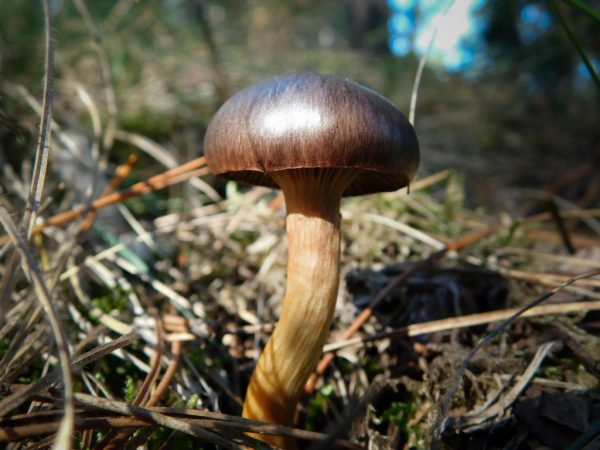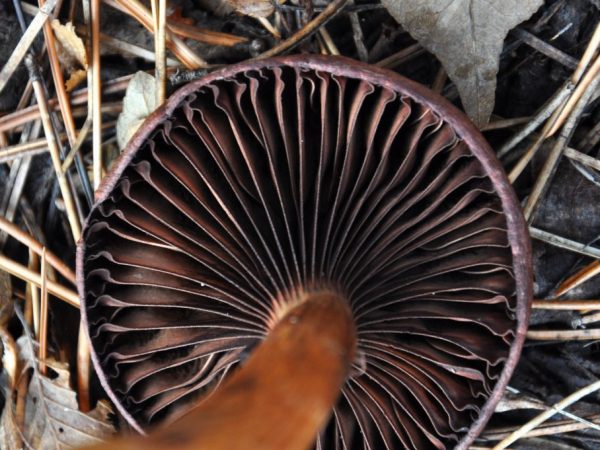Description of the mushroom purple moss
There are many edible mushrooms that are used in medicine and cooking. One of the most popular is purple moss. It is easy to find in both coniferous and mixed forests. Harvested from July to early October.

Description of the mushroom purple moss
Description of the appearance of the mushroom
The purple moss mushroom belongs to the Mokrukhovye family (Gomfidiaceae) and is edible. The diameter of its cap reaches 5-8 cm, it has a round-shaped blunt tubercle in the center, as the fungus develops, the cap gradually opens and takes the form of a funnel.
This mushroom is distinguished by its brown color with a wine tint. In young organisms, the central part of the cap is colored purple; with aging, the color becomes more uniform.
The cap is smooth to the touch, with young mushrooms a little slimy, especially in rainy weather. The pulp is thick, does not have a pronounced taste and smell.
The plates go a little on the leg, in young specimens they have a lilac tint, but with age they become black. They are covered with a brown slimy blanket.
The leg of purple moss reaches 10 cm in height, its thickness is 1-1.5 cm, it can be curved, slightly narrowing at the base. Its color is the same as the hat. The surface is smooth to the touch, has the remains of a private coverlet (covering the plates), which later become almost invisible. The pulp of the leg is fibrous, has a lilac tint, yellow near the base.
Related species of mushroom
Mokruha purple has several similar species. These include:
- Pine bark: it has a grayish cap and is a symbiont of conifers.
- M. felt: the cap of this mushroom is covered with a slight pubescence.
- M. spotted: the cap of this species is characterized by a grayish color with a brown tint.
- M. pink: the mushroom stands out with a bright pink cap.
All species have no resemblance to poisonous. They are often used in cooking.
Beneficial features
The purple moss mushroom is good for the body. Thanks to its unique composition, it improves memory, helps to overcome chronic fatigue and strengthen the immune system.
Also, the mushroom effectively helps in the fight against viral diseases, improves blood circulation and promotes the renewal of blood cells. It is often used in cosmetology.
Contraindications
This mushroom is difficult to confuse with poisonous, so it rarely brings harm to the body. It's best to stick to a few rules to keep yourself safe:
- But it is worth collecting mokruh near highways, next to large enterprises and large cities.
- People who have problems with the gastrointestinal tract or suffer from gout should not eat them in large quantities: this will lead to a deterioration in their health.
- Also, these mushrooms are contraindicated in children, because they contain a lot of quinine and fiber. It is difficult for a young organism to assimilate these elements.
- Individual intolerance should also be taken into account. Mushrooms can cause allergies, and in more severe cases, Quincke's edema.
Application

Mushrooms are eaten
Mokrukh is often used in cooking. They are pickled, fried and dried. This is a fairly nutritious product: the calorie content of 100 g of these mushrooms is 19 kcal. In a vegetarian diet, mokruhs are equivalent to meat dishes.
They are also used in cosmetology. Rinse hair with decoctions of moss, prepare products for fading skin.
In cooking
When cooking, mokruhs are used to complement main dishes. They are often mixed with other types of mushrooms. They go well with fish and meat. Before starting, the mushrooms are well sorted out, mucus and film are removed. To do this, the leg is cut lengthwise.
After that, the mushrooms are thoroughly washed and boiled for 15 minutes. They may change color a little, become darker, but this will not affect the taste in any way. When frying, you should not add oil: the pulp gives its own juice well, which is enough for cooking.
The most delicious are pickled purple moss, especially when combined with oil. To prepare pickled mushrooms you need:
- Place them in a large saucepan and cover with water, adding a pinch of salt and citric acid. Bring to a boil and simmer for 20 minutes.
- Drain and rinse the mushrooms.
- Better to use a deep container. Add 1 liter of water, 90 g of sugar, black pepper, cloves, salt, 100 ml of vinegar and bay leaf to it.
- After the marinade has boiled, add 1.5-2 kg of mushrooms. Cook for 15-20 minutes.
- After the mushrooms have settled to the bottom, put them together with the marinade in jars. Attention! The liquid should completely cover the moss.
- Add to banks 1 tbsp. l. oil (oil forms a protective film on the surface), close with nylon caps. Store in a cellar or refrigerator.
A delicious "Korean-style snack" is obtained from mokruh. To prepare this dish, the mushrooms are initially cleaned and boiled. Then fry with onions and add Korean-style carrots. The finished dish is seasoned with olive oil.
One of the most delicious purple mokruha dishes is omelette. To prepare it, take:
- mushrooms - 1 kg;
- eggs - 4 pcs.;
- prunes - 100 g;
- tomato - 1 pc.;
- semi-dry wine - 100 g;
- greens;
- salt to taste.
Fry the mushrooms and add finely chopped prunes to the pan (do not forget to steam the prunes first if they are very dry). After a few minutes, pour the wine and stew until the liquid evaporates. Then add the beaten eggs, chopped tomato, salt and pepper to taste.
The omelet is ready in 5 minutes. If desired, the dish is decorated with herbs.
In medicine
Most often, traditional medicine uses wormwood as a cure for neurodermatitis and staphylococcal infection. On their basis, alcoholic tinctures and ointments are prepared.
To preserve the beneficial properties, the mushroom is not peeled. Alcohol medicines are insisted for 15-20 days, the container is periodically shaken. The finished tincture is filtered and stored in the refrigerator. Such a medicine is used to get rid of pustules, and with sinusitis they are drunk 10-20 drops 2 times a day.
Mushroom extract of this type is able to restore the tone of aging skin, therefore, in cosmetology, it is often introduced into the composition of masks and face creams. Such cosmetics effectively narrow pores, help get rid of oily sheen and restore a healthy complexion.
Moruh-based products restore health and hair. They are especially useful for split ends and dull, weak curls. Regular rinsing with a decoction of these mushrooms can stop baldness.
Growing methods
At home, mokruhs are grown by sowing their mycelium. the acquired mycelium is mixed with 0.5 kg of dry soil or sand. Before planting, grooves of about 10 cm are made in the ground.The mycelium is evenly distributed over the surface (use 1 package per 1 m2). The site is sprinkled with soil mixed with compost at a rate of 1: 1. Pine needles are also used for shelter.
Irina Selyutina (Biologist):
It is necessary to plant purple mokruha next to a pine tree, because mycorrhiza is forming with this tree species.An annular hole is dug around the tree with an average depth of 10 cm (5-15 cm, it all depends on the depth of the roots at the soil surface). After that, the mixture of mycelium and sand is evenly distributed over the entire fossa. The mycelium will grow for a long time - as long as your pine tree will live. During the period when the mushrooms do not grow, it is advisable to sprinkle the planting site with an even layer of humus at the rate of 15 kg / m2.
You can also try growing it indoors, as you do with champignon. However, the results will be much worse because the probability of germination of mycelium is significantly reduced.
Pour 10 liters of water per 1 m2 once a week. The purpurea mildew yields a crop 4 times a year, the first harvest is carried out 2 months after sowing. If mushrooms grow poorly, it will be useful to add humus at the rate of 10 kg per 1 m2... Pine needles are also used for shelter.
Conclusion
The purpurine peel is an edible mushroom. It mainly grows in coniferous forests. In cooking, it is often used for pickling, added to soups and meat dishes.
Also, this species has a lot of useful elements. It is used in folk medicine to treat neurodermatitis and even staphylococcus. In addition, they are easy to grow on their own at home.



